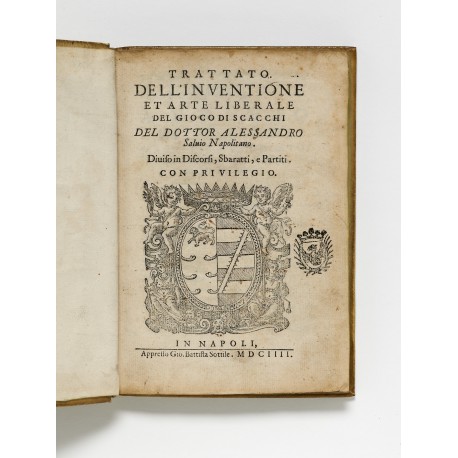Trattato. Dell’inventione et arte liberale del gioco di scacchi… Diuiso in Discorsi, Sbaratti, e Partiti
- Subjects
- Chess books - Early works to 1800
- Authors/Creators
- Salvio, Alessandro, c. 1570-c. 1640
- Printers/Publishers
- Sottile, Giovanni Battista, active 1602-1608
- Owners
- Blass, Robert, 1887-1975
- Boncompagni, Francesco, 1596-1644
- Boncompagni, Giacomo, 1548-1612
- Other names
- Costanzo, Fulvio, 1556-1627
Salvio, Alessandro
Bagnoli c. 1570 – c. 1640
Trattato. Dell’inventione et arte liberale del gioco di scacchi... Diuiso in Discorsi, Sbaratti, e Partiti.
Naples, Giovanni Battista Sottile, 1604
quarto (200 × 135 mm), (98) ff. signed a4 A–Z4 Aa2 (gathering O misbound) and paginated (8) 1–186 (2). Large woodcut insignia on title-page (arms of the dedicatee), woodcut of a chess board on folio D1 verso, numerous woodcut initials, and other ornaments.
provenance Giacomo Boncompagni, duke of Sora (1548–1612), inkstamp on title-page (a demi-dragon enclosed by a wreath, surmounted by a ducal crown), similar gilt stamp on binding, and Boncompagni library shelfmark R. III. 39 inscribed on front paste-down — Francesco Boncompagni (1596–1641), his emendations according to the printed errata, and warning ‘To the book thief’ on penultimate leaf1 — Robert Blass (1887–1975), ink stamp on endpaper — sale Christie’s, South Kensington, ‘Early Chess Literature from the celebrated Library of the late Dr. Robert Blass of Zurich’, London, 8 May 1992, lot 55
Margins browned and stained, other minor defects, but still a good copy.
binding contemporary vellum over boards, heraldic gilt stamp on spine (see above); edges stained green.
A volume from the celebrated chess library of Giacomo Boncompagni, duke of Sora (1548–1612), the natural son of Pope Gregory xiii, described by H.J.R. Murray as ‘the Maecenas of Italian chess’. Many of the great players of the period, including Ruy Lopez, Giulio Cesare Polerio, Girolamo Cascio, and Gioachino Greco, were members of his Roman household, or received benefices from him. The greater portion of the Boncompagni library was subsumed in the Biblioteca Vaticana, however several important manuscript notebooks by or emanating from Polerio were retained in the family (now Boncompagni-Ludovisi) until modern times.2
This first edition of Salvio’s treatise is dedicated to Fulvio di Costanzo, marchese di Corleto, and comprises thirty-one chapters with openings, eleven with games at odds, and twenty-one giochi di partiti, or problems, some being supplied from actual play. In his analysis Salvio follows the Neapolitan rule that the King forfeits his right to castle after receiving a check, which often made play to give or avoid an early check advisable that would otherwise appear without purpose. Some Neapolitan players, he tells us in Chapter xl, would prefer to lose a piece than the right to castle. Local rules prevailing elsewhere are carefully noted. Salvio’s Trattato marks the end of the first creative period in the history of the modern game. ‘Italian players were generally content to rely on Salvio for their openings, and made no attempt to advance the theory of play until the rise of the Modenese masters in 1750’.3 New editions of the work were published at Naples in 1612, 1618, 1634, and 1723.
The author had learned his play from Michele di Mauro and was one of the leading Neapolitan players from 1595 onwards, earning a European reputation when he defeated the reigning master Paolo Boi, called ‘Il Siracusano’ (1528–1598), in a match at Naples in 1598. Salvio was at the centre of chess activity in Naples and by 1634 was master of a ‘chess academy’ established there in the house of Alessandro Rovito. Besides this Trattato, he wrote La Scacciade, a chess tragedy reportedly printed at Naples in 1612 and 1618, and a biography of Giovanni Leonardo, called ‘Il Puttino’, the leading Italian player in the period 1560–1590, annexed to the 1634 reprint of the Trattato.
references Antonius Van der Linde, Geschichte und Litteratur des Schachspiels (Berlin 1874), i, p.369; Antonius Van der Linde, Das Erste Jahrtausend der Schachlitteratur (Berlin 1881), 2233; Bibliotheca Van der Linde-Nijmeijeriana: A catalogue of the Chess Collection in the Royal Library (The Hague 1955), 382; Adriano Chicco and Antonio Rosino, Storia degli scacchi in Italia: dalle origini ai giorni nostri (Venice 1990), pp.119–126; Manfred Zollinger, Bibliographie der Spielbücher des 15. bis 18. Jahrhunderts (Stuttgart 1996), p.25 no. 50; Alessandro Sanvito, Bibliografia italiana degli scacchi: dalle origini al 1999 (Milan 1999), p.83 no. 490
1. ‘Al Malandrino che ridà gli dià, Purchè vada a farse à rendere al mastro, et al uno et al altro gli dia come di sopra. Amen. F[rancesco] S[ora]’.
2. Harold J.R. Murray, A History of Chess (Oxford 1913), pp.817, 820–823; Michel Wittock, ‘Giacomo Boncompagni: heurs et malheurs d’une bibliothèque’ in Mélanges d’histoire de la reliure offerts à Georges Colin, edited by Claude Sorgeloos (Brussels 1998), pp.103–118.
3. Harold J.R. Murray, Short History of Chess (Oxford 1963), p.56.






